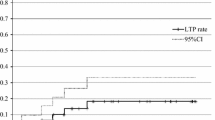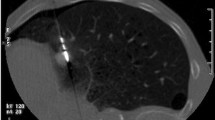Abstract
Objective
To retrospectively determine the frequency and risk factors of various side effects and complications after percutaneous computed tomography–guided radiofrequency (RF) ablation of lung tumors.
Methods
We reviewed and analyzed records of 112 treatment sessions in 57 of our patients (45 men and 12 women) with unresectable lung tumors treated by ablation. Risk factors, including sex, age, tumor diameter, tumor location, history of surgery, presence of pulmonary emphysema, electrode gauge, array diameter, patient position, maximum power output, ablation time, and minimum impedance during ablation, were analyzed using univariate and multivariate analyses.
Results
Total rates of side effects and minor and major complications occurred in 17%, 50%, and 8% of treatment sessions, respectively. Side effects, including pain during ablation (46% of sessions) and pleural effusion (13% of sessions), occurred with RF ablation. Minor complications, including pneumothorax not requiring chest tube drainage (30% of sessions), subcutaneous emphysema (16% of sessions), and hemoptysis (9% of sessions) also occurred after the procedure. Regarding major complications, three patients developed fever >38.5°C; three patients developed abscesses; two patients developed pneumothorax requiring chest tube insertion; and one patient had air embolism and was discharged without neurologic deficit. Univariate and multivariate analyses suggested that a lesion located ≤1 cm of the chest wall was significantly related to pain (p < 0.01, hazard index 5.76). Risk factors for pneumothorax increased significantly with previous pulmonary surgery (p < 0.05, hazard index 6.1) and presence of emphysema (p <0.01, hazard index 13.6).
Conclusion
The total complication rate for all treatment sessions was 58%, and 25% of patients did not have any complications after RF ablation. Although major complications can occur, RF ablation of lung tumors can be considered a safe and minimally invasive procedure.





Similar content being viewed by others
References
Gazelle GS, Goldberg SN, Solbiati L, et al. (2000) Tumor ablation with radiofrequency energy. Radiology 217:633–646
Dupuy DE, Goldberg SN (2001) Image-guided radiofrequency tumor ablation: Challenges and opportunities―Part 2. J Vasc Interv Radiol 12:1135–1148
Dupuy DE, Zagoria RJ, Akerley W, et al. (2000) Percutaneous radiofrequency ablation of malignancies in the lung. AJR Am J Roentgenol 174:57–59
Nishida T, Inoue K, Kawata Y, et al. (2002) Percutaneous radiofrequency ablation of lung neoplasms: A minimally invasive strategy for inoperable patients. J Am Coll Surg 195:426–430
Steinke K, King J, Glenn D, et al. (2003) Radiologic appearance and complications of percutaneous computed tomography-guided radiofrequency-ablated pulmonary metastases from colorectal carcinoma. J Comput Assist Tomogr 27:750–757
Akeboshi M, Yamakado K, Nakatsuka A, et al. (2004) Percutaneous radiofrequency ablation of lung neoplasms: Initial therapeutic response. J Vasc Interv Radiol 15:463–470
Yamagami T, Kato T, Hirota T, et al. (2006) Pneumothorax as a complication of percutaneous radiofrequency ablation for lung neoplasms. J Vasc Interv Radiol 17:1625–1629
Hiraki T, Tajiri N, Mimura H, et al. (2006) Pneumothorax, pleural effusion and chest tube placement after radiofrequency ablation of lung tumors: Incidence and risk factors. Radiology 241:275–273
Rose SC, Thistlethwaite PA, Sewell PE, et al. (2006) Lung cancer and radiofrequency ablation. J Vasc Interv Radiol 17:927–951
Goldberg SN, Grassi CJ, Cardell JF, et al. (2005) Image-guided tumor ablation: Standardization of terminology and reporting criteria. Radiology 235:728–739
Hoffmann RT, Jakobs TF, Lubienski A, et al. (2006) Percutaneous radiofrequency ablation of pulmonary tumors―Is there a difference between treatment under general anaesthesia and under conscious sedation? Eur J Radiol 59:168–174
Yasui K, Kanazawa S, Sano Y, et al. (2004) Thoracic tumors treated with CT-guided radiofrequency ablation: Initial experience. Radiology 231:850–857
Westcott JL, Rao N, Colley DP (1997) Transthoracic needle biopsy of small pulmonary nodules. Radiology 202:97–103
Covey AM, Gandhi R, Brody LA, et al. (2004) Factors associated with pneumothorax and pneumothorax requiring treatment after percutaneous lung biopsy in 443 consecutive patients. J Vasc Interv Radiol 15:479–483
Saji H, Nakamura H, Tsuchida T, et al. (2002) The incidence and the risk of pneumothorax and chest tube placement after percutaneous CT-guided lung biopsy. Chest 121:1251–1526
Kazerooni EA, Lim FT, Mikhail A, Martinez FJ (1996) Risk of pneumothorax in CT-guided transthoracic needle aspiration biopsy of the lung. Radiology 198:371–375
Laurent F, Michel P, Latrabe V, et al. (1999) Pneumothoraces and chest tube placement after CT-guided transthoracic lung biopsy using a coaxial technique: Incidence and risk factors. AJR Am J Roentgenol 172:1049–1053
Yeow KM, Su IH, Pan KT, et al. (2004) Risk factors of pneumothorax and bleeding: Multivariate analysis of 660 CT-guided coaxial cutting needle lung biopsies. Chest 126:748–754
Jin GY, Lee JM, Lee YC, et al. (2004) Primary and secondary lung malignancies treated with percutaneous radiofrequency ablation: evaluation with follow-up helical CT. AJR Am J Roentgenol 183:1013–1020
Lee JM, Jin GY, Goldberg SN, et al. (2004) Percutaneous radiofrequency ablation for inoperable non-small cell lung cancer and metastases: Preliminary report. Radiology 230:125–134
Suh RD, Wallace AB, Sheehan RE, et al. (2003) Unresectable pulmonary malignancies: CT-guided percutaneous radiofrequency ablation-preliminary results. Radiology 229:821–829
Gadaleta C, Mattioli V, Colucci G, et al. (2004) Radiofrequency ablation of 40 lung neoplasms: Preliminary results. AJR Am J Roentgenol 183:361–368
Belfiore G, Moggio G, Tedeschi E, et al. (2004) CT-guided radiofrequency ablation: A potential complementary therapy for patients with unresectable primary lung cancer―A preliminary report of 33 patients. AJR Am J Roentgenol 183:1003–1011
de Baere T, Palussiere J, Auperin A, et al. (2006) Midterm local efficacy and survival after radiofrequency ablation of lung tumors with minimum follow-up of 1 year: Prospective evaluation. Radiology 240:587–596
Bojarski JD, Dupuy DE, Mayo-Smith WW (2005) CT imaging findings of pulmonary neoplasms after treatment with radiofrequency ablation: Results in 32 tumors. AJR Am J Roentgenol 185:466–471
Herrera LJ, Fernando HC, Perry Y, et al. (2003) Radiofrequency ablation of pulmonary malignant tumors in nonsurgical candidates. J Thorac Cardiovasc Surg 125:929–937
Ghaye B, Bruyere PJ, Dondelinger RF (2006) Nonfetal systematic air embolism during percutaneous radiofrequency ablation of a pulmonary metastasis. AJR Am J Roentgenol 187:W327–W328
Okuma T, Matsuoka T, Tutumi S, et al. (2007) Air embolism during needle placement for CT-guided radiofrequency ablation for unresectable lung metastatic lesion. J Vasc Interv Radiol [in press]
Okuma T, Matsuoka T, Yamamoto A, et al. (2007) Factors contributing to cavitation after computed tomography-guided percutaneous radiofrequency ablation for lung tumors. J Vasc Interv Radiol 18:399–404
Yamakado K, Akeboshi M, Nakatsuka A, et al. (2005) Tumor seeding following lung radiofrequency ablation: A case report. Cardiovasc Interv Radiol 28:530–532
Vaughn C, Mychaskiw G, Swell P (2002) Massive hemorrhage during radiofrequency ablation of pulmonary neoplasm. Anesth Analg 94:1149–1151
Jin GY, Lee JM, Lee YC, Han YM (2004) Acute cerebral infarction after radiofrequency ablation of an atypical carcinoid pulmonary tumor. AJR Am J Roentgenol 182:990–992
Fernando HC, De Hoyos A, Landreneau RJ, et al. (2005) Radiofrequency ablation for the treatment of non-small cell lung cancer in marginal surgical candidates. J Thorac Cardiovasc Surg 129:639–644
Steinke K, King J, Glenn DW, et al. (2004) Percutaneous radiofrequency ablation of lung tumors with expandable needle electrodes: Tips from preliminary experience. AJR Am J Roentgenol 183:605–611
Author information
Authors and Affiliations
Corresponding author
Rights and permissions
About this article
Cite this article
Okuma, T., Matsuoka, T., Yamamoto, A. et al. Frequency and Risk Factors of Various Complications After Computed Tomography–Guided Radiofrequency Ablation of Lung Tumors. Cardiovasc Intervent Radiol 31, 122–130 (2008). https://doi.org/10.1007/s00270-007-9225-0
Received:
Revised:
Accepted:
Published:
Issue Date:
DOI: https://doi.org/10.1007/s00270-007-9225-0




